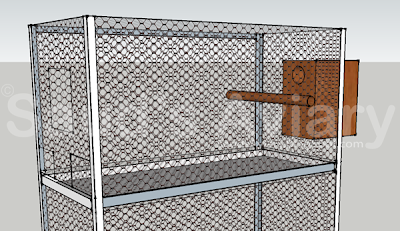4.8 Pieds & Other Mutations
In Pied birds, the melanin (blue pigment) is not produced uniformly in the feathers. In some areas the pigment is produced normally while in other areas the melanin is not produced at all. In a green bird the areas where no melanin is produced appear yellow. These areas are usually random in shape and size.
There are two different types of pied mutations. The dominant pied and the recessive pied. Some species of birds have dominant pieds, some have recessive pieds and some have both. The budgerigars, ringnecks and lovebirds have both types of pieds; the cockatiels have recessive pieds only.
The dominant pied gene (pi) is incomplete dominant to the normal. If you pair a dominant pied (SF) to a normal you will get 50% dominant pieds and 50% normals. Double factor dominant pieds show a heavier degree of piedness (yellow areas) than a single factor dominant pied
The recessive pied gene (s) is recessive to the normal. Pairing a recessive pied to a normal produces 100% normals split to recessive pied. In recessive pieds the degree of piedness is also passed on to the offspring. Heavily pied parents produce heavily pied chicks.
It is genetically not a good practice to mix the two different mutations of pieds in breeding. The resulting offspring will be visually difficult to classify as dominant or recessive pieds and you will also lose the distinctive features shown by each mutation. If however you do pair a dominant pied (SF) to a recessive pied you will get 50% dominant pieds split to recessive pieds and 50% normals split to recessive pieds. The two pied genes act independently of each other in inheritance just like any other pair of independent genes.
Visit http://www.budgieplace.com/colorsguide. ... minantpied to see the two types of pieds found in the budgerigar.
We have now covered all commonly found modes of inheritance including recessive, dominant, semi dominant and sex-linked. We have also talked about common mutations that are found across several species such as blue, ino, dark factor, grey, violet, pieds etc. We therefore have the tools to understand any other mutation that comes our way if we know its mode of inheritance. This ends the part of our tutorial on the basics of genetics. In our final chapter we will talk about using a genetics calculator to predict outcomes where several mutations are present in the parent birds.
Homework
With what mutation can a pied be combined to produce a bird that shows four colors green blue, yellow and white?
There are two different types of pied mutations. The dominant pied and the recessive pied. Some species of birds have dominant pieds, some have recessive pieds and some have both. The budgerigars, ringnecks and lovebirds have both types of pieds; the cockatiels have recessive pieds only.
The dominant pied gene (pi) is incomplete dominant to the normal. If you pair a dominant pied (SF) to a normal you will get 50% dominant pieds and 50% normals. Double factor dominant pieds show a heavier degree of piedness (yellow areas) than a single factor dominant pied
The recessive pied gene (s) is recessive to the normal. Pairing a recessive pied to a normal produces 100% normals split to recessive pied. In recessive pieds the degree of piedness is also passed on to the offspring. Heavily pied parents produce heavily pied chicks.
It is genetically not a good practice to mix the two different mutations of pieds in breeding. The resulting offspring will be visually difficult to classify as dominant or recessive pieds and you will also lose the distinctive features shown by each mutation. If however you do pair a dominant pied (SF) to a recessive pied you will get 50% dominant pieds split to recessive pieds and 50% normals split to recessive pieds. The two pied genes act independently of each other in inheritance just like any other pair of independent genes.
Visit http://www.budgieplace.com/colorsguide. ... minantpied to see the two types of pieds found in the budgerigar.
We have now covered all commonly found modes of inheritance including recessive, dominant, semi dominant and sex-linked. We have also talked about common mutations that are found across several species such as blue, ino, dark factor, grey, violet, pieds etc. We therefore have the tools to understand any other mutation that comes our way if we know its mode of inheritance. This ends the part of our tutorial on the basics of genetics. In our final chapter we will talk about using a genetics calculator to predict outcomes where several mutations are present in the parent birds.
Homework
With what mutation can a pied be combined to produce a bird that shows four colors green blue, yellow and white?


Comments
Post a Comment